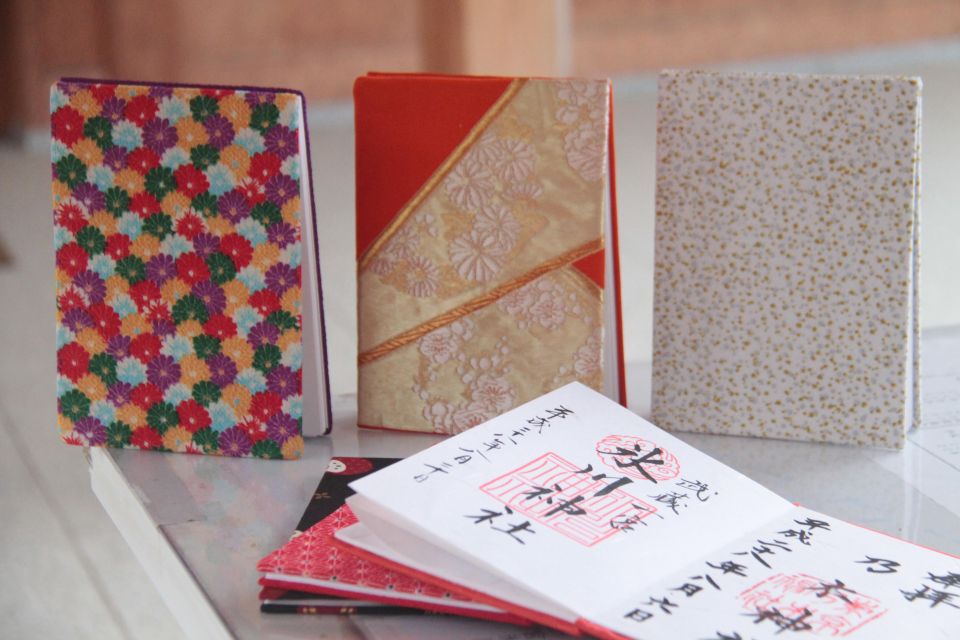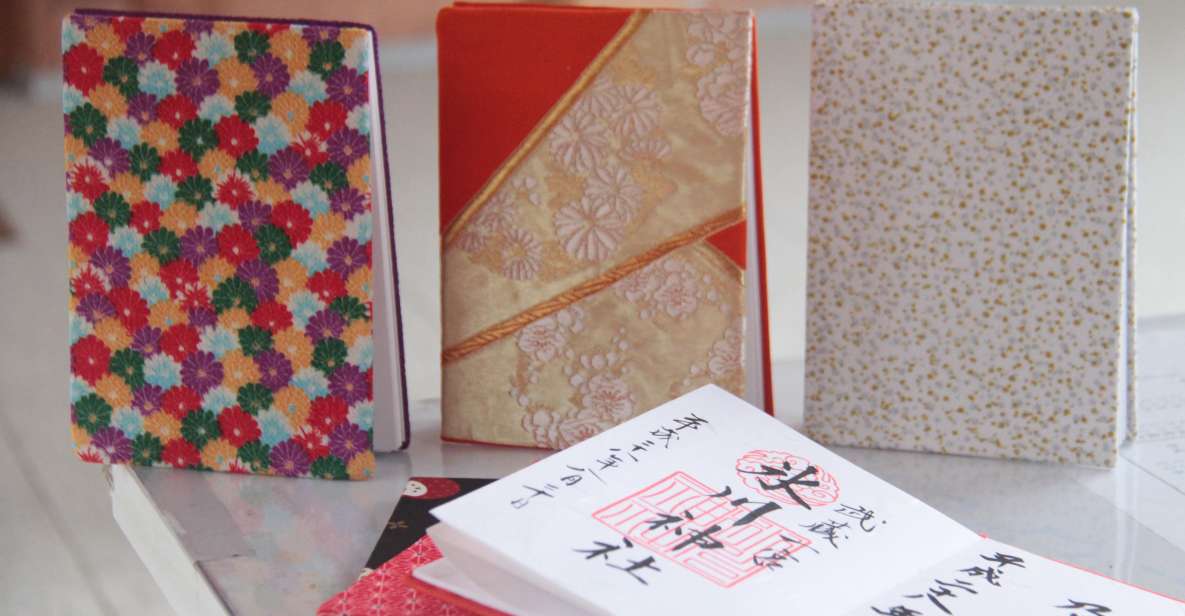Crafting a personalized temple stamp book with an experienced artist allows participants to enjoy a time-honored Japanese tradition. Visitors select vibrant kimono fabrics, then meticulously fold and glue the pages to create a unique notebook. The real excitement, however, lies in the hunt for authentic goshuin stamps from local shrines. With guidance on proper etiquette, guests thoughtfully approach the sacred sites, request the indelible marks, and carefully preserve them in their handmade journals. This hands-on workshop offers a chance to commemorate one’s spiritual journey while developing focus, concentration, and a sense of pride in the tactile process. Embark on this enriching cultural experience and…
Key Points

- Participate in a hands-on workshop to create a personalized notebook by folding and gluing pages.
- Collect goshuin (temple stamps) from a local shrine, following proper etiquette and reverence.
- Learn about the significance and symbolism of the goshuin stamp in Japanese culture.
- Receive guidance from an experienced instructor on selecting unique kimono fabrics to cover the notebook.
- Engage in a small group setting, with accessibility considerations for participants with mobility impairments.
It's also worth checking out some other tours and experiences nearby.
Kimono Fabric Selection

Participants begin the experience by selecting from over 100 different kimono fabrics, each with its own unique patterns and colors, to create the cover for their goshuin notebook.
The fabrics come in a wide array of styles, from bold and vibrant to delicate and subdued. Guests are encouraged to choose a fabric that speaks to their personal aesthetic or represents a significant moment or memory.
With the guidance of the instructor, they carefully examine the various options, feeling the soft, luxurious texture of the silk and appreciating the intricate designs.
This selection process allows participants to infuse their goshuin notebook with a touch of Japanese artistry and individuality, making it a truly one-of-a-kind creation.
Notebook Folding and Gluing
Next, participants meticulously fold and glue the pages together to create the goshuin notebook. Under the instructor’s guidance, they learn the proper techniques for precisely aligning the papers and applying the adhesive to ensure a sturdy and uniform structure.
This hands-on process allows guests to fully enjoy the craftsmanship, as they thoughtfully shape the foundation of their personalized journal.
The experience evokes a sense of:
- Focus and concentration as they carefully fold each page.
- Satisfaction in the tactile process of gluing the papers together.
- Pride as they watch their unique notebook take shape.
- Anticipation for the shrine visit and first goshuin stamp.
Goshuin Stamp Collection
After completing the notebook creation, participants excitedly head to a nearby local shrine where they’ll receive their first goshuin stamp. The goshuin is a unique stamp that temple and shrine visitors can collect, marking their spiritual journey and commemorating their visit. Guests learn the proper etiquette for approaching the shrine, including the appropriate way to bow and offer their respects before requesting the stamp. With anticipation, they watch as the shrine’s monk or caretaker thoughtfully presses the intricate, calligraphic stamp onto the page, creating an indelible record of their experience.
| Goshuin Stamp | Purpose | Significance | Etiquette |
|---|---|---|---|
| Unique Stamp | Mark Spiritual Journey | Commemorate Visit | Proper Bowing, Offering Respects |
| Calligraphic Design | Indelible Record | Spiritual Connection | Requesting Stamp |
Shrine Etiquette
Visitors thoughtfully approach the shrine, following the traditional etiquette to demonstrate respect for the sacred space. They begin by stopping to rinse their hands and mouth at the temizuya, or purification fountain, to cleanse themselves before entering.
Next, they bow deeply at the torii gate, the symbolic entrance to the shrine grounds, to show reverence for the Shinto deities enshrined within.
The ritual continues as they:
- Toss a coin into the offertory box to make a wish or give thanks.
- Ring the large bell to announce their arrival.
- Bow twice, clap twice, then bow once more in a specific manner.
- Silently offer their prayers, reflecting on the significance of the shrine.
These steps help visitors connect with the spiritual essence of the shrine and experience the reverence of the Japanese pilgrimage.
Meeting Point and Accessibility
The meeting point for the temple stamp book workshop is in front of the entrance located between the drug store and Cozy Corner cake shop. Visitors will need to navigate about 10 steps to reach the classroom and shrine, which may pose a challenge for those with mobility impairments. The experience isn’t suitable for children under 3 years old.
The workshop takes place in a small group setting, limited to 8 participants. After selecting from over 100 kimono fabric options, guests will learn how to properly fold and glue papers together to create their unique goshuin notebook.
Afterward, they’ll visit a local shrine and receive their first stamp, seeing Japan’s traditional shrine etiquette.
Workshop Inclusions
The workshop fee covers the cost of selecting from over 100 different kimono fabrics to create the goshuin notebook, as well as the fee for receiving a stamp at the local shrine.
This hands-on experience allows participants to:
- Immerse themselves in the rich culture and tradition of Japan’s centuries-old temple stamp collecting practice.
- Customize their very own notebook using premium kimono fabrics, bringing a unique touch to their memento.
- Engage with a local shrine, gaining insights into the proper etiquette and reverence for this sacred space.
- Proudly display their handcrafted notebook, filled with the first of many shrine stamps to come.
This inclusive workshop promises an unforgettable journey into Japan’s revered temple culture.
Age and Mobility Restrictions
Designed for adult participants, this hands-on workshop isn’t suitable for children under 3 years old due to safety concerns.
Plus, individuals with mobility impairments may find it challenging to navigate the steps leading to the classroom and shrine, potentially limiting their ability to fully engage with the experience.
The temple stamp book workshop is tailored for able-bodied adults who can comfortably move around and participate in the various activities. This includes selecting fabric, folding and gluing papers, and visiting the nearby shrine to receive the coveted goshuin stamp.
The organizers have designed the experience with these restrictions in mind, ensuring a safe and enjoyable workshop for all eligible participants.
Duration and Group Size
This temple stamp book workshop runs for a duration of 2 hours, providing participants with sufficient time to fully enjoy the creative process and shrine visit. The experience is purposefully kept to a small group size, limited to just 8 individuals, ensuring personalized attention from the skilled instructors and a more intimate, focused atmosphere throughout the workshop.
The small group setting allows for:
- Individualized guidance and support from the artist, ensuring each participant’s creation is unique and reflective of their personal style.
- Ample opportunity for hands-on practice and experimentation with the kimono fabrics and notebook assembly techniques.
- Meaningful discussions and exchange of cultural insights about the significance of goshuin stamps and shrine etiquette.
- A heightened sense of camaraderie and shared experience among the participants.
Here's a few more nearby tours and experiences we think you'll like.
Frequently Asked Questions
Can I Bring My Own Kimono Fabric to Use?
Yes, participants are welcome to bring their own kimono fabric to use in the workshop. The host will provide a wide selection of fabrics, but using personal materials can make the experience more meaningful and unique for each participant.
Will the Shrine Accept Foreign Currency for the Stamp Fee?
The shrine will likely accept foreign currency for the stamp fee, though it’s best to check beforehand. The experience leaders can provide guidance on the proper procedures and etiquette for obtaining the shrine stamp.
Are There Any Restrictions on the Types of Goshuin Stamps I Can Collect?
There are no restrictions on the types of goshuin stamps one can collect during the experience. Participants are free to visit and receive stamps from any shrines or temples they wish, expanding their collection.
Can I Take Photos Inside the Shrine During the Visit?
Guests are generally allowed to take photos inside the shrine during the visit, but they should be respectful and avoid disrupting the sacred atmosphere. Photography policies may vary, so it’s best to check with the shrine attendants beforehand.
Is There a Dress Code or Specific Attire Required for the Shrine Visit?
The shrine visit typically requires modest, respectful attire. Participants should avoid shorts, tank tops, or revealing clothing. Comfortable walking shoes are recommended, as the shrine may have uneven ground. The experience leaders can provide guidance on appropriate shrine etiquette.
Not for you? Here's more of our most recent tour reviews happening neaby
- Tokyo: Zen Meditation at a Private Temple With a Monk
- From Tokyo: Private Nikko World Heritage Sights Day Trip
- From Tokyo: Private Mount Fuji and Hakone Day Trip
- Shibuya: Explore the Hidden Local Bars – 3.5 Hours
- Breakfast Ramen Tour in Shinjuku, Tokyo
- Tokyo: Daikoku Car Meet and JDM Culture Guided Tour
- Shimbashi Walking Food Tour With a Local Guide in Tokyo
- Tokyo: Shibuya Highlights Walking Tour
- Private Ginza Architecture Tour
- Tokyo: Kimono Rental / Yukata Rental in Asakusa
- Tokyo Bar Hopping: the True off the Beaten Path Experience
- A Day as a Sushi Chef
- Shibuya & Harajuku: Hidden Gems & Highlights Private Tour
- Tokyo Asakusa to Ueno, 2 Hours Walking Tour to Feel Japan
- Japanese Traditional Music Show in Tokyo
Recap
The ‘Make a Temple Stamp Book With Artist’ workshop provides a meaningful way to preserve one’s spiritual journey. Participants will learn the proper etiquette for obtaining goshuin stamps, then carefully assemble a personalized notebook to house these indelible marks.
This hands-on experience allows individuals to commemorate their travels while developing focus, concentration, and a sense of pride in the tactile process. It’s an opportunity to create a cherished keepsake that reflects one’s spiritual exploration.





